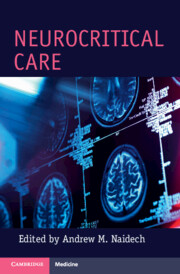Book contents
- Neurocritical Care
- Neurocritical Care
- Copyright page
- Contents
- Contributors
- 1 Introduction
- 2 Intracranial Pressure Monitoring and Management
- 3 Disorders of Temperature Regulation
- 4 Approach to Neuroimaging of the Brain, Vessels, and Cerebral Edema
- 5 Airway and Ventilator Management of the Neurologically Critically Ill Patient
- 6 Neurocritical Care Pharmacology
- 7 Intracerebral Hemorrhage
- 8 Correction of Coagulopathy
- 9 Subarachnoid Hemorrhage
- 10 Subdural Hematoma
- 11 Critical Care Management of Neurotrauma
- 12 Critical Care Management before and after Open and Intravascular Procedures
- 13 Shared Decision-Making in the Neuro-ICU
- 14 Status Epilepticus and EEG Monitoring
- 15 Evaluation of the Comatose Patient and Overview of the Brain Death Examination
- Index
- References
13 - Shared Decision-Making in the Neuro-ICU
Published online by Cambridge University Press: 19 May 2022
- Neurocritical Care
- Neurocritical Care
- Copyright page
- Contents
- Contributors
- 1 Introduction
- 2 Intracranial Pressure Monitoring and Management
- 3 Disorders of Temperature Regulation
- 4 Approach to Neuroimaging of the Brain, Vessels, and Cerebral Edema
- 5 Airway and Ventilator Management of the Neurologically Critically Ill Patient
- 6 Neurocritical Care Pharmacology
- 7 Intracerebral Hemorrhage
- 8 Correction of Coagulopathy
- 9 Subarachnoid Hemorrhage
- 10 Subdural Hematoma
- 11 Critical Care Management of Neurotrauma
- 12 Critical Care Management before and after Open and Intravascular Procedures
- 13 Shared Decision-Making in the Neuro-ICU
- 14 Status Epilepticus and EEG Monitoring
- 15 Evaluation of the Comatose Patient and Overview of the Brain Death Examination
- Index
- References
Summary
Shared decision-making (SDM) is a process involving clinicians, patients, and surrogates that is grounded in making treatment decisions based on the best available scientific evidence and patient’s values, goals, and preferences. This collaborative style of decision-making is urgently needed in the Neuro-ICU to meet the existing deficiencies in clinician–family communication and decision-making. SDM conceptual models include the Ottawa Decision Support Framework (ODSF) and Interprofessional Shared Decision-Making Model (IP-SDM) and form the basis of decision aids (DAs), which are SDM tools. The goal of SDM is to increase patient-value congruent decision-making, improve the quality of communication between clinicians and patient/surrogates, reduce decisional conflict and passivity, increase knowledge of decisions, and promote realistic expectations of treatments and outcomes. Further research is needed and currently underway to establish the efficacy of SDM in the Neuro-ICU on family, clinician, patient, and healthcare utilization outcomes.
- Type
- Chapter
- Information
- Neurocritical Care , pp. 252 - 270Publisher: Cambridge University PressPrint publication year: 2022



